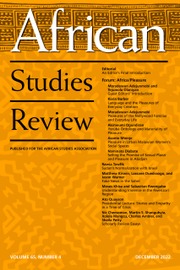The Routledge Handbook of Francophone Africa is an accessible and engaging collection of essays about the origins and history of Francophone identity and Francophonie through the prism of French and Belgian colonialism in Africa. The book is an extensive, yet digestible, collection of essays exploring the historical and contemporary relationships between French-speaking colonial powers and Africa and nuanced ways in which “Francophone,” “Francophonie,” and related concepts must be understood. While they are often associated with the historical relationships between France and Africa since colonial times or specific geographic and cultural boundaries, these terms are fluid, complex, and increasingly reflective of identities that include non-French-speaking African nations.
The handbook has an introduction and twenty-eight chapters that provide important contexts for understanding the social, political, economic, and cultural significance of Francophone identity and Francophonie as an organizational entity. Describing “Francophone” in the introduction to the book, Tony Chafer and Margaret A. Majumdar write:
On the one hand, its historical roots in the French colonization of Africa in the nineteenth century have proved remarkably resilient in the face of decolonization and subsequent developments. On the other hand, the notion of ‘Francophone Africa’ has evolved into a multidimensional construct, which conveys a material, as well as an imagined reality. As such, it can be characterized in a number of different ways.
Chafer and Majumdar use the term “francophone” to refer to “Africans who regularly use French as a means of communication, either as their mother tongue or as a second language.” However, the scholars explain: “The term ‘Francophone’ (with a capital ‘F’), on the other hand, is increasingly used today in a geopolitical sense to describe a group of countries, members of the Organisation Internationale de la Francophonie (OIF), that have decided to collaborate politically and within which French is the working language.” A corollary to this term is “Francophonie.” In the fourth chapter, Majumdar states: “When it is written with the upper-case F, Francophonie usually refers to the organization, Organisation Internationale de la Francophonie (International Francophone Organisation), which has gradually established its institutional apparatus from the middle of the twentieth century.”
A key contribution of the anthology is its emphasis on the idea that French colonization in Africa would have been incomplete—or perhaps even impossible—without the existing political and social fragmentations within Africa between the mid-1850s and the 1890s. Aware of the dissensions among warlords and other factions who viewed royal and imperial leaders in West and Equatorial African empires as proponents of a jihadist agenda, French colonial forces exploited these internal divisions to impose their dominance. They justified their persecution of such leaders with the support of local dissenters. According to Alexander Keese, the French perceived Islamic leaders in West Africa—such as Cheikh Umar Tall in Mali and Samory Touré in Guinea—as “dangerous agitators and Islamic despots.” The French adopted a similarly aggressive stance toward religious leaders in Central Africa. As Keese notes, “colonial intervention also meant destroying certain local religions, such as during the conquest of Dahomey.” Consequently, African leaders saw their states invaded and dominated by French colonial forces, who by the 1850s were increasingly focused on military conquest rather than the mere establishment of colonial trading posts.
Another key contribution of the anthology is its challenge to the enduring and pervasive myth that France generously granted citizenship to the elite inhabitants of its West African colonies. Correcting this misconception, Keese writes:
Between 1848 and 1957, the situation of the Four Communes remained an anomaly. Although the French had a debate on the use (and the problems) of ‘educated natives’ (évolués), who had a degree of ‘French schooling’ and were the typical group to serve as clerks at various levels, access to citizenship was rare. Between 1935 and 1949, in AOF [Afrique Occidentale Française], the average number of new French citizens was 17 per year, of which roughly half came from the Senegalese districts outside of the Four Communes.
Moreover, the Routledge Handbook of Francophone Africa succinctly highlights crucial—yet often overlooked—aspects of African history that help explain the origins of the contemporary challenges faced by various states across the continent. In the ninth chapter, Guy Vanthemsche provides such historical context by illustrating, for example, the strategic ways in which Belgium transformed itself from a relatively minor European nation into a major Western colonial empire by the end of the nineteenth century. As the chapter shows, the creation of the État Indépendant du Congo (Congo Free State) at the conclusion of the Berlin Conference in February 1885 was largely the result of the political “maneuvers” of King Leopold II of Belgium, who persuaded other European powers—such as the United Kingdom and France—to recognize his personal claim to a vast Central African territory, under the pretense that it would not threaten their own spheres of influence. Tragically, King Leopold II’s non-state-led colonial enterprise became one of the wealthiest and most brutal regimes in Africa, sustained in part through the use of local African soldiers, much like other European powers did elsewhere on the continent. Given the extreme exploitation and violence inflicted by Belgian officers and their Force publique troops, it was perhaps inevitable that widespread uprisings would erupt. Indeed, massive revolts occurred in the 1890s, despite the harsh repression that characterized Leopold’s regime in the Congo.
The Routledge Handbook of Francophone Africa is an essential resource for exploring the history of Francophone identity, the concept of Francophonie, and the multiple nuances embedded within these terms—their interrelations, and their specific cultural and historical contexts. As such, it serves as an excellent companion not only for students, but also for scholars and general readers with interests in African Francophone studies, African postcolonial studies, empire studies, and related fields.

